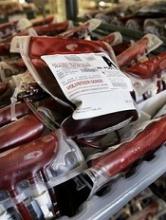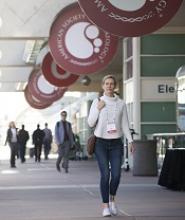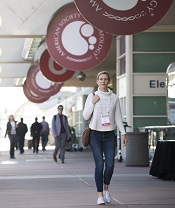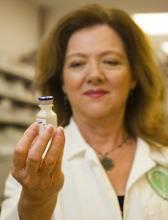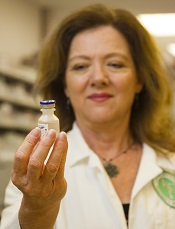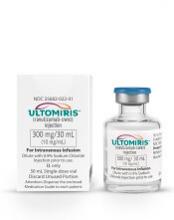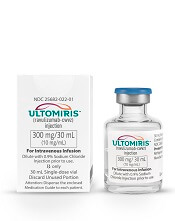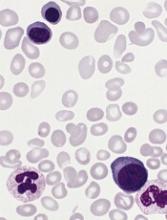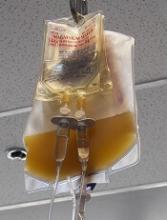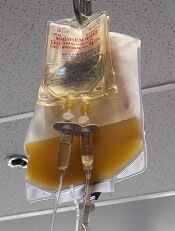User login
Team reports long-term effects of blood management
An initiative that reduced red blood cell (RBC) transfusions and increased moderate anemia in hospital did not adversely impact patients long-term, according to an analysis.
Researchers found that an increase in moderate in-hospital anemia did not increase subsequent RBC use, readmission, or mortality over the next 6 months.
However, authors of a related editorial argued that additional factors must be assessed to truly determine the effects of moderate anemia on patient outcomes.
The study and the editorial were published in the Annals of Internal Medicine.
Study: Long-term outcomes
Nareg H. Roubinian, MD, of Kaiser Permanente Northern California in Oakland, and colleagues sought to evaluate the impact of blood management programs—starting in 2010—that included blood-sparing surgical and medical techniques, increased use of hemostatic and cell salvage agents, and treatment of suboptimal iron stores before surgery.
In previous retrospective cohort studies, the researchers had found that blood conservation strategies did not impact in-hospital or 30-day mortality rates, which was consistent with short-term safety data from clinical trials and other observational studies.
Their new report on longer-term outcomes was based on data from Kaiser Permanente Northern California for 445,371 adults who had 801,261 hospitalizations with discharges between 2010 and 2014.
In this cohort, moderate anemia (hemoglobin between 7 g/dL and 10 g/dL) at discharge occurred in 119,489 patients (27%) and 187,440 hospitalizations overall (23%).
Over the 2010-2014 period, RBC transfusions decreased by more than 25% in the inpatient and outpatient settings. In parallel, the prevalence of moderate anemia at hospital discharge increased from 20% to 25%.
However, the risks of subsequent RBC transfusions and rehospitalization after discharge with anemia decreased during the study period, and mortality rates stayed steady or decreased slightly.
Among patients with moderate anemia, the proportion with subsequent RBC transfusions within 6 months decreased from 18.9% in 2010 to 16.8% in 2014 (P<0.001), while the rate of rehospitalization within 6 months decreased from 36.5% to 32.8% over that same time period (P<0.001).
The adjusted 6-month mortality rate likewise decreased from 16.1% to 15.6% (P=0.004) over that time period among patients with moderate anemia.
“These data support the efficacy and safety of practice recommendations to limit red blood cell transfusion in patients with anemia during and after hospitalization,” the researchers wrote.
However, they also said additional studies are needed to guide anemia management, particularly since persistent anemia has impacts on quality of life that are “likely to be substantial” and linked to the severity of that anemia.
This study was supported by a grant from the National Heart, Lung, and Blood Institute. Dr. Roubinian and several coauthors reported grants from the National Institutes of Health.
Editorial: Aim to treat anemia, not tolerate it
Dr. Roubinian and his colleagues’ findings warrant some scrutiny, according to Aryeh Shander, MD, of Englewood Hospital and Medical Center in New Jersey, and Lawrence Tim Goodnough, MD, of Stanford University in California.
“Missing here is a wide spectrum of morbidity outcomes and issues related to diminished quality of life that do not reach the level of severity that would necessitate admission but nonetheless detract from patients’ health and well-being,” Drs. Shander and Goodnough wrote in a related editorial.
They also noted that transfusion rate is not a clinical outcome, adding that readmission and mortality are important outcomes, but they do not accurately or fully reflect patient well-being.
While blood management initiatives may be a safe practice, as the study suggests, proper management of anemia after discharge may actually improve outcomes, given the many consequences of anemia, Drs. Shander and Goodnough wrote.
The pair suggested that, instead of again testing whether restricting transfusions is acceptable because of lack of impact on outcomes, future studies could evaluate a “more sensible” hypothesis that proper anemia management, especially post-discharge, could improve outcomes.
“Let’s increase efforts to prevent and treat anemia properly, rather than requiring patients to tolerate it,” Drs. Shander and Goodnough wrote.
Dr. Shander reported consulting fees from Vifor and AMAG. Dr. Goodnough reported having no relevant financial disclosures.
An initiative that reduced red blood cell (RBC) transfusions and increased moderate anemia in hospital did not adversely impact patients long-term, according to an analysis.
Researchers found that an increase in moderate in-hospital anemia did not increase subsequent RBC use, readmission, or mortality over the next 6 months.
However, authors of a related editorial argued that additional factors must be assessed to truly determine the effects of moderate anemia on patient outcomes.
The study and the editorial were published in the Annals of Internal Medicine.
Study: Long-term outcomes
Nareg H. Roubinian, MD, of Kaiser Permanente Northern California in Oakland, and colleagues sought to evaluate the impact of blood management programs—starting in 2010—that included blood-sparing surgical and medical techniques, increased use of hemostatic and cell salvage agents, and treatment of suboptimal iron stores before surgery.
In previous retrospective cohort studies, the researchers had found that blood conservation strategies did not impact in-hospital or 30-day mortality rates, which was consistent with short-term safety data from clinical trials and other observational studies.
Their new report on longer-term outcomes was based on data from Kaiser Permanente Northern California for 445,371 adults who had 801,261 hospitalizations with discharges between 2010 and 2014.
In this cohort, moderate anemia (hemoglobin between 7 g/dL and 10 g/dL) at discharge occurred in 119,489 patients (27%) and 187,440 hospitalizations overall (23%).
Over the 2010-2014 period, RBC transfusions decreased by more than 25% in the inpatient and outpatient settings. In parallel, the prevalence of moderate anemia at hospital discharge increased from 20% to 25%.
However, the risks of subsequent RBC transfusions and rehospitalization after discharge with anemia decreased during the study period, and mortality rates stayed steady or decreased slightly.
Among patients with moderate anemia, the proportion with subsequent RBC transfusions within 6 months decreased from 18.9% in 2010 to 16.8% in 2014 (P<0.001), while the rate of rehospitalization within 6 months decreased from 36.5% to 32.8% over that same time period (P<0.001).
The adjusted 6-month mortality rate likewise decreased from 16.1% to 15.6% (P=0.004) over that time period among patients with moderate anemia.
“These data support the efficacy and safety of practice recommendations to limit red blood cell transfusion in patients with anemia during and after hospitalization,” the researchers wrote.
However, they also said additional studies are needed to guide anemia management, particularly since persistent anemia has impacts on quality of life that are “likely to be substantial” and linked to the severity of that anemia.
This study was supported by a grant from the National Heart, Lung, and Blood Institute. Dr. Roubinian and several coauthors reported grants from the National Institutes of Health.
Editorial: Aim to treat anemia, not tolerate it
Dr. Roubinian and his colleagues’ findings warrant some scrutiny, according to Aryeh Shander, MD, of Englewood Hospital and Medical Center in New Jersey, and Lawrence Tim Goodnough, MD, of Stanford University in California.
“Missing here is a wide spectrum of morbidity outcomes and issues related to diminished quality of life that do not reach the level of severity that would necessitate admission but nonetheless detract from patients’ health and well-being,” Drs. Shander and Goodnough wrote in a related editorial.
They also noted that transfusion rate is not a clinical outcome, adding that readmission and mortality are important outcomes, but they do not accurately or fully reflect patient well-being.
While blood management initiatives may be a safe practice, as the study suggests, proper management of anemia after discharge may actually improve outcomes, given the many consequences of anemia, Drs. Shander and Goodnough wrote.
The pair suggested that, instead of again testing whether restricting transfusions is acceptable because of lack of impact on outcomes, future studies could evaluate a “more sensible” hypothesis that proper anemia management, especially post-discharge, could improve outcomes.
“Let’s increase efforts to prevent and treat anemia properly, rather than requiring patients to tolerate it,” Drs. Shander and Goodnough wrote.
Dr. Shander reported consulting fees from Vifor and AMAG. Dr. Goodnough reported having no relevant financial disclosures.
An initiative that reduced red blood cell (RBC) transfusions and increased moderate anemia in hospital did not adversely impact patients long-term, according to an analysis.
Researchers found that an increase in moderate in-hospital anemia did not increase subsequent RBC use, readmission, or mortality over the next 6 months.
However, authors of a related editorial argued that additional factors must be assessed to truly determine the effects of moderate anemia on patient outcomes.
The study and the editorial were published in the Annals of Internal Medicine.
Study: Long-term outcomes
Nareg H. Roubinian, MD, of Kaiser Permanente Northern California in Oakland, and colleagues sought to evaluate the impact of blood management programs—starting in 2010—that included blood-sparing surgical and medical techniques, increased use of hemostatic and cell salvage agents, and treatment of suboptimal iron stores before surgery.
In previous retrospective cohort studies, the researchers had found that blood conservation strategies did not impact in-hospital or 30-day mortality rates, which was consistent with short-term safety data from clinical trials and other observational studies.
Their new report on longer-term outcomes was based on data from Kaiser Permanente Northern California for 445,371 adults who had 801,261 hospitalizations with discharges between 2010 and 2014.
In this cohort, moderate anemia (hemoglobin between 7 g/dL and 10 g/dL) at discharge occurred in 119,489 patients (27%) and 187,440 hospitalizations overall (23%).
Over the 2010-2014 period, RBC transfusions decreased by more than 25% in the inpatient and outpatient settings. In parallel, the prevalence of moderate anemia at hospital discharge increased from 20% to 25%.
However, the risks of subsequent RBC transfusions and rehospitalization after discharge with anemia decreased during the study period, and mortality rates stayed steady or decreased slightly.
Among patients with moderate anemia, the proportion with subsequent RBC transfusions within 6 months decreased from 18.9% in 2010 to 16.8% in 2014 (P<0.001), while the rate of rehospitalization within 6 months decreased from 36.5% to 32.8% over that same time period (P<0.001).
The adjusted 6-month mortality rate likewise decreased from 16.1% to 15.6% (P=0.004) over that time period among patients with moderate anemia.
“These data support the efficacy and safety of practice recommendations to limit red blood cell transfusion in patients with anemia during and after hospitalization,” the researchers wrote.
However, they also said additional studies are needed to guide anemia management, particularly since persistent anemia has impacts on quality of life that are “likely to be substantial” and linked to the severity of that anemia.
This study was supported by a grant from the National Heart, Lung, and Blood Institute. Dr. Roubinian and several coauthors reported grants from the National Institutes of Health.
Editorial: Aim to treat anemia, not tolerate it
Dr. Roubinian and his colleagues’ findings warrant some scrutiny, according to Aryeh Shander, MD, of Englewood Hospital and Medical Center in New Jersey, and Lawrence Tim Goodnough, MD, of Stanford University in California.
“Missing here is a wide spectrum of morbidity outcomes and issues related to diminished quality of life that do not reach the level of severity that would necessitate admission but nonetheless detract from patients’ health and well-being,” Drs. Shander and Goodnough wrote in a related editorial.
They also noted that transfusion rate is not a clinical outcome, adding that readmission and mortality are important outcomes, but they do not accurately or fully reflect patient well-being.
While blood management initiatives may be a safe practice, as the study suggests, proper management of anemia after discharge may actually improve outcomes, given the many consequences of anemia, Drs. Shander and Goodnough wrote.
The pair suggested that, instead of again testing whether restricting transfusions is acceptable because of lack of impact on outcomes, future studies could evaluate a “more sensible” hypothesis that proper anemia management, especially post-discharge, could improve outcomes.
“Let’s increase efforts to prevent and treat anemia properly, rather than requiring patients to tolerate it,” Drs. Shander and Goodnough wrote.
Dr. Shander reported consulting fees from Vifor and AMAG. Dr. Goodnough reported having no relevant financial disclosures.
DRd improves PFS in transplant-ineligible MM
SAN DIEGO—An interim analysis from the MAIA trial showed that adding daratumumab to lenalidomide and dexamethasone could significantly improve progression-free survival (PFS) in older patients with multiple myeloma (MM) who were ineligible for transplant.
The 30-month PFS rate was 71% in patients who received daratumumab plus lenalidomide and dexamethasone (DRd) and 56% in patients who received only lenalidomide and dexamethasone (Rd).
“These results support DRd as a new standard of care for elderly patients with myeloma who are ineligible for transplant,” said Thierry Facon, MD, of Hôpital Claude Huriez and the University of Lille in France.
Dr. Facon presented results from MAIA during the late-breaking abstracts session at the 2018 ASH Annual Meeting (abstract LBA-2).
The phase 3 trial (NCT02252172) enrolled 737 transplant-ineligible patients with newly diagnosed MM.
The patients were randomly assigned to DRd or Rd. Daratumumab was given at 16 mg/kg weekly for cycles 1 and 2, every other week for cycles 3 through 6, and every 4 weeks from cycle 7 until disease progression.
Lenalidomide was given at 25 mg orally per day on days 1-21 until disease progression, and dexamethasone was given at 40 mg orally or intravenously weekly until disease progression.
The median patient age was 73 years, and 99% of all patients were 65 or older. Demographic and clinical characteristics were well balanced between the treatment arms.
Results
The primary endpoint of PFS was superior with DRd.
At a median follow-up of 28 months, the median PFS had not been reached in the DRd arm and was 31.9 months in the Rd arm.
The 30-month PFS rate was 71% in the DRd arm and 56% in the Rd arm (hazard ratio [HR]=0.56; P<0.0001).
DRd was associated with a significantly higher overall response rate than Rd—93% and 81%, respectively (P<0.0001).
The complete response rates were 48% and 25%, respectively (P<0.0001). The rates of very good partial response or better were 79% and 53%, respectively (P<0.0001). And the rates of minimal residual disease negativity were 24% and 7%, respectively (P<0.0001).
DRd was associated with infusion-related reactions in 41% of patients, and 3% were grade 3 or 4 in severity.
Hematologic treatment-emergent adverse events of grade 3 or higher that were more common with DRd than Rd included neutropenia (50% vs. 35%) and lymphopenia (15% vs. 11%).
Conversely, grade 3/4 thrombocytopenia (7% vs. 9%) and anemia (12% vs. 20%) were more frequent with Rd.
Nonhematologic treatment-emergent adverse events that were more frequent with DRd included diarrhea, constipation, fatigue, peripheral edema, and pneumonia.
Rates of asthenia, back pain, nausea, and deep vein thrombosis/pulmonary embolism were similar between the treatment arms.
Janssen funded this study. Dr. Facon reported relationships with Celgene, Janssen, Takeda, Sanofi, Amgen, Karyopharm, and Oncopeptides.
SAN DIEGO—An interim analysis from the MAIA trial showed that adding daratumumab to lenalidomide and dexamethasone could significantly improve progression-free survival (PFS) in older patients with multiple myeloma (MM) who were ineligible for transplant.
The 30-month PFS rate was 71% in patients who received daratumumab plus lenalidomide and dexamethasone (DRd) and 56% in patients who received only lenalidomide and dexamethasone (Rd).
“These results support DRd as a new standard of care for elderly patients with myeloma who are ineligible for transplant,” said Thierry Facon, MD, of Hôpital Claude Huriez and the University of Lille in France.
Dr. Facon presented results from MAIA during the late-breaking abstracts session at the 2018 ASH Annual Meeting (abstract LBA-2).
The phase 3 trial (NCT02252172) enrolled 737 transplant-ineligible patients with newly diagnosed MM.
The patients were randomly assigned to DRd or Rd. Daratumumab was given at 16 mg/kg weekly for cycles 1 and 2, every other week for cycles 3 through 6, and every 4 weeks from cycle 7 until disease progression.
Lenalidomide was given at 25 mg orally per day on days 1-21 until disease progression, and dexamethasone was given at 40 mg orally or intravenously weekly until disease progression.
The median patient age was 73 years, and 99% of all patients were 65 or older. Demographic and clinical characteristics were well balanced between the treatment arms.
Results
The primary endpoint of PFS was superior with DRd.
At a median follow-up of 28 months, the median PFS had not been reached in the DRd arm and was 31.9 months in the Rd arm.
The 30-month PFS rate was 71% in the DRd arm and 56% in the Rd arm (hazard ratio [HR]=0.56; P<0.0001).
DRd was associated with a significantly higher overall response rate than Rd—93% and 81%, respectively (P<0.0001).
The complete response rates were 48% and 25%, respectively (P<0.0001). The rates of very good partial response or better were 79% and 53%, respectively (P<0.0001). And the rates of minimal residual disease negativity were 24% and 7%, respectively (P<0.0001).
DRd was associated with infusion-related reactions in 41% of patients, and 3% were grade 3 or 4 in severity.
Hematologic treatment-emergent adverse events of grade 3 or higher that were more common with DRd than Rd included neutropenia (50% vs. 35%) and lymphopenia (15% vs. 11%).
Conversely, grade 3/4 thrombocytopenia (7% vs. 9%) and anemia (12% vs. 20%) were more frequent with Rd.
Nonhematologic treatment-emergent adverse events that were more frequent with DRd included diarrhea, constipation, fatigue, peripheral edema, and pneumonia.
Rates of asthenia, back pain, nausea, and deep vein thrombosis/pulmonary embolism were similar between the treatment arms.
Janssen funded this study. Dr. Facon reported relationships with Celgene, Janssen, Takeda, Sanofi, Amgen, Karyopharm, and Oncopeptides.
SAN DIEGO—An interim analysis from the MAIA trial showed that adding daratumumab to lenalidomide and dexamethasone could significantly improve progression-free survival (PFS) in older patients with multiple myeloma (MM) who were ineligible for transplant.
The 30-month PFS rate was 71% in patients who received daratumumab plus lenalidomide and dexamethasone (DRd) and 56% in patients who received only lenalidomide and dexamethasone (Rd).
“These results support DRd as a new standard of care for elderly patients with myeloma who are ineligible for transplant,” said Thierry Facon, MD, of Hôpital Claude Huriez and the University of Lille in France.
Dr. Facon presented results from MAIA during the late-breaking abstracts session at the 2018 ASH Annual Meeting (abstract LBA-2).
The phase 3 trial (NCT02252172) enrolled 737 transplant-ineligible patients with newly diagnosed MM.
The patients were randomly assigned to DRd or Rd. Daratumumab was given at 16 mg/kg weekly for cycles 1 and 2, every other week for cycles 3 through 6, and every 4 weeks from cycle 7 until disease progression.
Lenalidomide was given at 25 mg orally per day on days 1-21 until disease progression, and dexamethasone was given at 40 mg orally or intravenously weekly until disease progression.
The median patient age was 73 years, and 99% of all patients were 65 or older. Demographic and clinical characteristics were well balanced between the treatment arms.
Results
The primary endpoint of PFS was superior with DRd.
At a median follow-up of 28 months, the median PFS had not been reached in the DRd arm and was 31.9 months in the Rd arm.
The 30-month PFS rate was 71% in the DRd arm and 56% in the Rd arm (hazard ratio [HR]=0.56; P<0.0001).
DRd was associated with a significantly higher overall response rate than Rd—93% and 81%, respectively (P<0.0001).
The complete response rates were 48% and 25%, respectively (P<0.0001). The rates of very good partial response or better were 79% and 53%, respectively (P<0.0001). And the rates of minimal residual disease negativity were 24% and 7%, respectively (P<0.0001).
DRd was associated with infusion-related reactions in 41% of patients, and 3% were grade 3 or 4 in severity.
Hematologic treatment-emergent adverse events of grade 3 or higher that were more common with DRd than Rd included neutropenia (50% vs. 35%) and lymphopenia (15% vs. 11%).
Conversely, grade 3/4 thrombocytopenia (7% vs. 9%) and anemia (12% vs. 20%) were more frequent with Rd.
Nonhematologic treatment-emergent adverse events that were more frequent with DRd included diarrhea, constipation, fatigue, peripheral edema, and pneumonia.
Rates of asthenia, back pain, nausea, and deep vein thrombosis/pulmonary embolism were similar between the treatment arms.
Janssen funded this study. Dr. Facon reported relationships with Celgene, Janssen, Takeda, Sanofi, Amgen, Karyopharm, and Oncopeptides.
Risk of second cancers in Hodgkin lymphoma survivors
Survivors of childhood Hodgkin lymphoma (HL) have a 14-fold higher risk of second cancers compared to the general population, according to new research.
The subsequent malignant neoplasms (SMNs) observed in HL survivors tended to follow specific patterns depending on the patient’s age at treatment, sex, treatment modality, and region of the body treated.
And although the risk of SMNs appears to be somewhat lower for HL patients treated in more recent decades, it is still significantly higher than the risk in the general population, according to investigators.
Anna S. Holmqvist, MD, PhD, of the University of Lund in Sweden, and her colleagues conducted this research and reported the results in Cancer.
The investigators looked at data from the Late Effects Study Group, a multinational cohort of patients age 16 or younger who were treated for HL and other cancers from 1955 through 1986.
The current report is the third update from an expanded cohort including data on 1,136 patients with a median follow-up of 26.6 years. The median patient age at diagnosis was 11 years (range, birth to 16 years), and the patients were followed for 23,212 person-years after HL diagnosis.
In all, 162 patients developed 196 SMNs, including breast cancer (n=54), basal cell carcinoma (n=34), thyroid cancer (n=30), colorectal cancer (n=15), lung cancer (n=11), and other malignancies (n=40). The disease site was not available in 12 cases.
The cumulative incidence of any SMN 40 years after HL diagnosis was 26.4%. By age 50, the cumulative incidence of any SMN was 27.2%.
The standardized incidence ratio for the entire cohort was 14.0, compared with the general population as derived from the Surveillance, Epidemiology and End Results database.
Risk factors by cancer type
Females treated with chest radiotherapy between the ages of 10 and 16 who did not receive alkylating agents or received low doses of alkylating agents had the highest risk of developing breast cancer. The cumulative incidence of breast cancer by age 50 was 45.3% in these patients.
The patients with the highest risk for subsequent lung cancer were males treated with chest radiotherapy before age 10. The cumulative incidence of lung cancer by age 50 was 4.2% in these patients.
Patients with the highest risk for colorectal cancer had received abdominal/pelvic radiotherapy and high-dose alkylating agents. The cumulative incidence of colorectal cancer by age 50 was 9.5% in these patients.
Patients with the highest risk for thyroid cancers were females who had been treated with radiotherapy to the neck before the age of 10. The cumulative incidence of thyroid cancer by age 50 was 17.3% in these patients.
The investigators noted that HL patients treated more recently are likely to have received lower doses and volumes of radiotherapy compared to patients treated in the 1950s, ’60s and ’70s.
“However, for the cohort of patients treated between 1955 and 1986, it is clear that continued surveillance for SMNs is essential because their risk continues to increase as these survivors enter their fourth and subsequent decades of life,” the investigators wrote.
They did not report a funding source for this research or make any conflict-of-interest disclosures.
Survivors of childhood Hodgkin lymphoma (HL) have a 14-fold higher risk of second cancers compared to the general population, according to new research.
The subsequent malignant neoplasms (SMNs) observed in HL survivors tended to follow specific patterns depending on the patient’s age at treatment, sex, treatment modality, and region of the body treated.
And although the risk of SMNs appears to be somewhat lower for HL patients treated in more recent decades, it is still significantly higher than the risk in the general population, according to investigators.
Anna S. Holmqvist, MD, PhD, of the University of Lund in Sweden, and her colleagues conducted this research and reported the results in Cancer.
The investigators looked at data from the Late Effects Study Group, a multinational cohort of patients age 16 or younger who were treated for HL and other cancers from 1955 through 1986.
The current report is the third update from an expanded cohort including data on 1,136 patients with a median follow-up of 26.6 years. The median patient age at diagnosis was 11 years (range, birth to 16 years), and the patients were followed for 23,212 person-years after HL diagnosis.
In all, 162 patients developed 196 SMNs, including breast cancer (n=54), basal cell carcinoma (n=34), thyroid cancer (n=30), colorectal cancer (n=15), lung cancer (n=11), and other malignancies (n=40). The disease site was not available in 12 cases.
The cumulative incidence of any SMN 40 years after HL diagnosis was 26.4%. By age 50, the cumulative incidence of any SMN was 27.2%.
The standardized incidence ratio for the entire cohort was 14.0, compared with the general population as derived from the Surveillance, Epidemiology and End Results database.
Risk factors by cancer type
Females treated with chest radiotherapy between the ages of 10 and 16 who did not receive alkylating agents or received low doses of alkylating agents had the highest risk of developing breast cancer. The cumulative incidence of breast cancer by age 50 was 45.3% in these patients.
The patients with the highest risk for subsequent lung cancer were males treated with chest radiotherapy before age 10. The cumulative incidence of lung cancer by age 50 was 4.2% in these patients.
Patients with the highest risk for colorectal cancer had received abdominal/pelvic radiotherapy and high-dose alkylating agents. The cumulative incidence of colorectal cancer by age 50 was 9.5% in these patients.
Patients with the highest risk for thyroid cancers were females who had been treated with radiotherapy to the neck before the age of 10. The cumulative incidence of thyroid cancer by age 50 was 17.3% in these patients.
The investigators noted that HL patients treated more recently are likely to have received lower doses and volumes of radiotherapy compared to patients treated in the 1950s, ’60s and ’70s.
“However, for the cohort of patients treated between 1955 and 1986, it is clear that continued surveillance for SMNs is essential because their risk continues to increase as these survivors enter their fourth and subsequent decades of life,” the investigators wrote.
They did not report a funding source for this research or make any conflict-of-interest disclosures.
Survivors of childhood Hodgkin lymphoma (HL) have a 14-fold higher risk of second cancers compared to the general population, according to new research.
The subsequent malignant neoplasms (SMNs) observed in HL survivors tended to follow specific patterns depending on the patient’s age at treatment, sex, treatment modality, and region of the body treated.
And although the risk of SMNs appears to be somewhat lower for HL patients treated in more recent decades, it is still significantly higher than the risk in the general population, according to investigators.
Anna S. Holmqvist, MD, PhD, of the University of Lund in Sweden, and her colleagues conducted this research and reported the results in Cancer.
The investigators looked at data from the Late Effects Study Group, a multinational cohort of patients age 16 or younger who were treated for HL and other cancers from 1955 through 1986.
The current report is the third update from an expanded cohort including data on 1,136 patients with a median follow-up of 26.6 years. The median patient age at diagnosis was 11 years (range, birth to 16 years), and the patients were followed for 23,212 person-years after HL diagnosis.
In all, 162 patients developed 196 SMNs, including breast cancer (n=54), basal cell carcinoma (n=34), thyroid cancer (n=30), colorectal cancer (n=15), lung cancer (n=11), and other malignancies (n=40). The disease site was not available in 12 cases.
The cumulative incidence of any SMN 40 years after HL diagnosis was 26.4%. By age 50, the cumulative incidence of any SMN was 27.2%.
The standardized incidence ratio for the entire cohort was 14.0, compared with the general population as derived from the Surveillance, Epidemiology and End Results database.
Risk factors by cancer type
Females treated with chest radiotherapy between the ages of 10 and 16 who did not receive alkylating agents or received low doses of alkylating agents had the highest risk of developing breast cancer. The cumulative incidence of breast cancer by age 50 was 45.3% in these patients.
The patients with the highest risk for subsequent lung cancer were males treated with chest radiotherapy before age 10. The cumulative incidence of lung cancer by age 50 was 4.2% in these patients.
Patients with the highest risk for colorectal cancer had received abdominal/pelvic radiotherapy and high-dose alkylating agents. The cumulative incidence of colorectal cancer by age 50 was 9.5% in these patients.
Patients with the highest risk for thyroid cancers were females who had been treated with radiotherapy to the neck before the age of 10. The cumulative incidence of thyroid cancer by age 50 was 17.3% in these patients.
The investigators noted that HL patients treated more recently are likely to have received lower doses and volumes of radiotherapy compared to patients treated in the 1950s, ’60s and ’70s.
“However, for the cohort of patients treated between 1955 and 1986, it is clear that continued surveillance for SMNs is essential because their risk continues to increase as these survivors enter their fourth and subsequent decades of life,” the investigators wrote.
They did not report a funding source for this research or make any conflict-of-interest disclosures.
FDA approves first treatment for BPDCN
The U.S. Food and Drug Administration (FDA) has approved tagraxofusp-erzs (Elzonris) to treat patients age 2 and older who have blastic plasmacytoid dendritic cell neoplasm (BPDCN).
Tagraxofusp-erzs (formerly SL-401) is a CD123-directed cytotoxin that is the first FDA-approved treatment for BPDCN.
Tagraxofusp-erzs will be commercially available in early 2019, according to Stemline Therapeutics, makers of the drug.
The prescribing information for tagraxofusp-erzs contains a boxed warning noting that the drug is associated with an increased risk of capillary leak syndrome (CLS), which may be life-threatening or fatal.
The FDA previously granted tagraxofusp-erzs breakthrough therapy and orphan drug designations and assessed the drug under priority review.
The FDA’s approval of tagraxofusp-erzs was based on a phase 1 trial (STML-401-0114; NCT02113982).
The trial enrolled 47 patients with BPDCN, including 32 who were treatment-naïve and 15 who were previously treated.
Patients received tagraxofusp-erzs intravenously on days 1-5 of a 21-day cycle for multiple consecutive cycles. The trial had a dose-escalation stage (stage 1), an expansion stage (stage 2), a confirmatory stage (stage 3), and a stage that enabled uninterrupted access to tagraxofusp-erzs (stage 4).
In the confirmatory stage, 13 patients with treatment-naïve BPDCN received tagraxofusp-erzs at the recommended dose and schedule—12 mcg/kg daily for 5 days of a 21-day cycle.
Efficacy was based on the rate of complete response (CR) or clinical complete response (CRc). CRc was defined as CR with residual skin abnormality not indicative of active disease.
The CR/CRc rate was 53.8% (7/13), and the median duration of CR/CRc was not reached (range, 3.9 to 12.2 months).
The safety of tagraxofusp-erzs was assessed in 94 adults with treatment-naïve or previously treated myeloid malignancies, including 58 patients with BPDCN, who were treated at the recommended dose and schedule.
There were two fatal adverse events—both CLS. Eleven percent of patients discontinued treatment with tagraxofusp-erzs due to an adverse event. The most common of these were hepatic toxicities and CLS.
The most common adverse events overall were CLS (55%), nausea (49%), fatigue (45%), peripheral edema (43%), pyrexia (43%), and weight increase (31%).
The most common laboratory abnormalities were decreases in albumin (77%), platelets (67%), hemoglobin (60%), calcium (57%), and sodium (50%), as well as increases in glucose (87%), alanine aminotransferase (82%), and aspartate aminotransferase (79%).
The U.S. Food and Drug Administration (FDA) has approved tagraxofusp-erzs (Elzonris) to treat patients age 2 and older who have blastic plasmacytoid dendritic cell neoplasm (BPDCN).
Tagraxofusp-erzs (formerly SL-401) is a CD123-directed cytotoxin that is the first FDA-approved treatment for BPDCN.
Tagraxofusp-erzs will be commercially available in early 2019, according to Stemline Therapeutics, makers of the drug.
The prescribing information for tagraxofusp-erzs contains a boxed warning noting that the drug is associated with an increased risk of capillary leak syndrome (CLS), which may be life-threatening or fatal.
The FDA previously granted tagraxofusp-erzs breakthrough therapy and orphan drug designations and assessed the drug under priority review.
The FDA’s approval of tagraxofusp-erzs was based on a phase 1 trial (STML-401-0114; NCT02113982).
The trial enrolled 47 patients with BPDCN, including 32 who were treatment-naïve and 15 who were previously treated.
Patients received tagraxofusp-erzs intravenously on days 1-5 of a 21-day cycle for multiple consecutive cycles. The trial had a dose-escalation stage (stage 1), an expansion stage (stage 2), a confirmatory stage (stage 3), and a stage that enabled uninterrupted access to tagraxofusp-erzs (stage 4).
In the confirmatory stage, 13 patients with treatment-naïve BPDCN received tagraxofusp-erzs at the recommended dose and schedule—12 mcg/kg daily for 5 days of a 21-day cycle.
Efficacy was based on the rate of complete response (CR) or clinical complete response (CRc). CRc was defined as CR with residual skin abnormality not indicative of active disease.
The CR/CRc rate was 53.8% (7/13), and the median duration of CR/CRc was not reached (range, 3.9 to 12.2 months).
The safety of tagraxofusp-erzs was assessed in 94 adults with treatment-naïve or previously treated myeloid malignancies, including 58 patients with BPDCN, who were treated at the recommended dose and schedule.
There were two fatal adverse events—both CLS. Eleven percent of patients discontinued treatment with tagraxofusp-erzs due to an adverse event. The most common of these were hepatic toxicities and CLS.
The most common adverse events overall were CLS (55%), nausea (49%), fatigue (45%), peripheral edema (43%), pyrexia (43%), and weight increase (31%).
The most common laboratory abnormalities were decreases in albumin (77%), platelets (67%), hemoglobin (60%), calcium (57%), and sodium (50%), as well as increases in glucose (87%), alanine aminotransferase (82%), and aspartate aminotransferase (79%).
The U.S. Food and Drug Administration (FDA) has approved tagraxofusp-erzs (Elzonris) to treat patients age 2 and older who have blastic plasmacytoid dendritic cell neoplasm (BPDCN).
Tagraxofusp-erzs (formerly SL-401) is a CD123-directed cytotoxin that is the first FDA-approved treatment for BPDCN.
Tagraxofusp-erzs will be commercially available in early 2019, according to Stemline Therapeutics, makers of the drug.
The prescribing information for tagraxofusp-erzs contains a boxed warning noting that the drug is associated with an increased risk of capillary leak syndrome (CLS), which may be life-threatening or fatal.
The FDA previously granted tagraxofusp-erzs breakthrough therapy and orphan drug designations and assessed the drug under priority review.
The FDA’s approval of tagraxofusp-erzs was based on a phase 1 trial (STML-401-0114; NCT02113982).
The trial enrolled 47 patients with BPDCN, including 32 who were treatment-naïve and 15 who were previously treated.
Patients received tagraxofusp-erzs intravenously on days 1-5 of a 21-day cycle for multiple consecutive cycles. The trial had a dose-escalation stage (stage 1), an expansion stage (stage 2), a confirmatory stage (stage 3), and a stage that enabled uninterrupted access to tagraxofusp-erzs (stage 4).
In the confirmatory stage, 13 patients with treatment-naïve BPDCN received tagraxofusp-erzs at the recommended dose and schedule—12 mcg/kg daily for 5 days of a 21-day cycle.
Efficacy was based on the rate of complete response (CR) or clinical complete response (CRc). CRc was defined as CR with residual skin abnormality not indicative of active disease.
The CR/CRc rate was 53.8% (7/13), and the median duration of CR/CRc was not reached (range, 3.9 to 12.2 months).
The safety of tagraxofusp-erzs was assessed in 94 adults with treatment-naïve or previously treated myeloid malignancies, including 58 patients with BPDCN, who were treated at the recommended dose and schedule.
There were two fatal adverse events—both CLS. Eleven percent of patients discontinued treatment with tagraxofusp-erzs due to an adverse event. The most common of these were hepatic toxicities and CLS.
The most common adverse events overall were CLS (55%), nausea (49%), fatigue (45%), peripheral edema (43%), pyrexia (43%), and weight increase (31%).
The most common laboratory abnormalities were decreases in albumin (77%), platelets (67%), hemoglobin (60%), calcium (57%), and sodium (50%), as well as increases in glucose (87%), alanine aminotransferase (82%), and aspartate aminotransferase (79%).
FDA approves ravulizumab for PNH
The U.S. Food and Drug Administration (FDA) has approved ravulizumab-cwvz (Ultomiris) to treat adults with paroxysmal nocturnal hemoglobinuria (PNH).
Ravulizumab is a long-acting C5 complement inhibitor, administered every 8 weeks, that has been shown to prevent hemolysis.
The prescribing information for ravulizumab includes a boxed warning stating that meningococcal infections/sepsis have occurred in patients treated with the drug, and these adverse effects can become life-threatening or fatal if not recognized and treated early.
Ravulizumab is available only through a restricted program under a Risk Evaluation and Mitigation Strategy.
The FDA previously granted the application for ravulizumab priority review, and the product received orphan drug designation from the FDA.
The FDA granted the approval of ravulizumab to Alexion Pharmaceuticals.
The FDA’s approval of ravulizumab is based on results from two phase 3 studies, one in patients who had previously received treatment with a complement inhibitor and one in patients who were complement-inhibitor-naïve. Both studies were recently published in Blood.
Efficacy in inhibitor-experienced patients
In one study (NCT03056040), researchers compared ravulizumab administered every 8 weeks to eculizumab administered every 2 weeks in complement-inhibitor-experienced patients.
The trial included 195 PNH patients who were taking eculizumab for more than 6 months. They were randomized to switch to ravulizumab (n=97) or continue on eculizumab (n=98).
Ravulizumab proved noninferior to eculizumab for all endpoints studied (P<0.0006), including:
- Percentage change in lactate dehydrogenase (LDH): difference, 9.21% (95% CI: -0.42 to 18.84; P=0.058 for superiority)
- Breakthrough hemolysis: difference, 5.1 (95% CI: -8.89 to 18.99)
- Change in FACIT-Fatigue score: difference, 1.47 (95% CI: -0.21 to 3.15)
- Transfusion avoidance: difference, 5.5 (95% CI: -4.27 to 15.68)
- Stabilized hemoglobin: difference, 1.4 (95% CI: -10.41 to 13.31).
Efficacy in inhibitor-naïve patients
In another study (NCT02946463), researchers compared ravulizumab and eculizumab in 246 PNH patients who had not previously received a complement inhibitor.
Ravulizumab was noninferior to eculizumab for all endpoints (P<0.0001), including:
- Transfusion avoidance: 73.6% vs 66.1%; difference of 6.8% (95% CI: -4.66 to 18.14)
- LDH normalization: 53.6% vs 49.4%; odds ratio=1.19 (95% CI: 0.80 to 1.77)
- Percent reduction in LDH: -76.8% vs -76.0%; difference of -0.83% (95% CI: -5.21 to 3.56)
- Change in FACIT-Fatigue score: 7.07 vs 6.40; difference of 0.67 (95% CI: -1.21 to 2.55)
- Breakthrough hemolysis: 4.0% vs 10.7%; difference of -6.7% (95% CI: -14.21 to 0.18)
- Stabilized hemoglobin: 68.0% vs 64.5%; difference of 2.9 (95% CI: -8.80 to 14.64).
Safety in both trials
The safety data from both trials included 441 adults who received ravulizumab (n=222) or eculizumab (n=219) for a median of 6 months.
The most frequent adverse events in both arms (ravulizumab and eculizumab, respectively) were upper respiratory tract infection (39% and 39%) and headache (32% and 26%).
Serious adverse events occurred in 15 (6.8%) patients treated with ravulizumab. These events included hyperthermia and pyrexia.
There was one fatal case of sepsis in a patient treated with ravulizumab.
The U.S. Food and Drug Administration (FDA) has approved ravulizumab-cwvz (Ultomiris) to treat adults with paroxysmal nocturnal hemoglobinuria (PNH).
Ravulizumab is a long-acting C5 complement inhibitor, administered every 8 weeks, that has been shown to prevent hemolysis.
The prescribing information for ravulizumab includes a boxed warning stating that meningococcal infections/sepsis have occurred in patients treated with the drug, and these adverse effects can become life-threatening or fatal if not recognized and treated early.
Ravulizumab is available only through a restricted program under a Risk Evaluation and Mitigation Strategy.
The FDA previously granted the application for ravulizumab priority review, and the product received orphan drug designation from the FDA.
The FDA granted the approval of ravulizumab to Alexion Pharmaceuticals.
The FDA’s approval of ravulizumab is based on results from two phase 3 studies, one in patients who had previously received treatment with a complement inhibitor and one in patients who were complement-inhibitor-naïve. Both studies were recently published in Blood.
Efficacy in inhibitor-experienced patients
In one study (NCT03056040), researchers compared ravulizumab administered every 8 weeks to eculizumab administered every 2 weeks in complement-inhibitor-experienced patients.
The trial included 195 PNH patients who were taking eculizumab for more than 6 months. They were randomized to switch to ravulizumab (n=97) or continue on eculizumab (n=98).
Ravulizumab proved noninferior to eculizumab for all endpoints studied (P<0.0006), including:
- Percentage change in lactate dehydrogenase (LDH): difference, 9.21% (95% CI: -0.42 to 18.84; P=0.058 for superiority)
- Breakthrough hemolysis: difference, 5.1 (95% CI: -8.89 to 18.99)
- Change in FACIT-Fatigue score: difference, 1.47 (95% CI: -0.21 to 3.15)
- Transfusion avoidance: difference, 5.5 (95% CI: -4.27 to 15.68)
- Stabilized hemoglobin: difference, 1.4 (95% CI: -10.41 to 13.31).
Efficacy in inhibitor-naïve patients
In another study (NCT02946463), researchers compared ravulizumab and eculizumab in 246 PNH patients who had not previously received a complement inhibitor.
Ravulizumab was noninferior to eculizumab for all endpoints (P<0.0001), including:
- Transfusion avoidance: 73.6% vs 66.1%; difference of 6.8% (95% CI: -4.66 to 18.14)
- LDH normalization: 53.6% vs 49.4%; odds ratio=1.19 (95% CI: 0.80 to 1.77)
- Percent reduction in LDH: -76.8% vs -76.0%; difference of -0.83% (95% CI: -5.21 to 3.56)
- Change in FACIT-Fatigue score: 7.07 vs 6.40; difference of 0.67 (95% CI: -1.21 to 2.55)
- Breakthrough hemolysis: 4.0% vs 10.7%; difference of -6.7% (95% CI: -14.21 to 0.18)
- Stabilized hemoglobin: 68.0% vs 64.5%; difference of 2.9 (95% CI: -8.80 to 14.64).
Safety in both trials
The safety data from both trials included 441 adults who received ravulizumab (n=222) or eculizumab (n=219) for a median of 6 months.
The most frequent adverse events in both arms (ravulizumab and eculizumab, respectively) were upper respiratory tract infection (39% and 39%) and headache (32% and 26%).
Serious adverse events occurred in 15 (6.8%) patients treated with ravulizumab. These events included hyperthermia and pyrexia.
There was one fatal case of sepsis in a patient treated with ravulizumab.
The U.S. Food and Drug Administration (FDA) has approved ravulizumab-cwvz (Ultomiris) to treat adults with paroxysmal nocturnal hemoglobinuria (PNH).
Ravulizumab is a long-acting C5 complement inhibitor, administered every 8 weeks, that has been shown to prevent hemolysis.
The prescribing information for ravulizumab includes a boxed warning stating that meningococcal infections/sepsis have occurred in patients treated with the drug, and these adverse effects can become life-threatening or fatal if not recognized and treated early.
Ravulizumab is available only through a restricted program under a Risk Evaluation and Mitigation Strategy.
The FDA previously granted the application for ravulizumab priority review, and the product received orphan drug designation from the FDA.
The FDA granted the approval of ravulizumab to Alexion Pharmaceuticals.
The FDA’s approval of ravulizumab is based on results from two phase 3 studies, one in patients who had previously received treatment with a complement inhibitor and one in patients who were complement-inhibitor-naïve. Both studies were recently published in Blood.
Efficacy in inhibitor-experienced patients
In one study (NCT03056040), researchers compared ravulizumab administered every 8 weeks to eculizumab administered every 2 weeks in complement-inhibitor-experienced patients.
The trial included 195 PNH patients who were taking eculizumab for more than 6 months. They were randomized to switch to ravulizumab (n=97) or continue on eculizumab (n=98).
Ravulizumab proved noninferior to eculizumab for all endpoints studied (P<0.0006), including:
- Percentage change in lactate dehydrogenase (LDH): difference, 9.21% (95% CI: -0.42 to 18.84; P=0.058 for superiority)
- Breakthrough hemolysis: difference, 5.1 (95% CI: -8.89 to 18.99)
- Change in FACIT-Fatigue score: difference, 1.47 (95% CI: -0.21 to 3.15)
- Transfusion avoidance: difference, 5.5 (95% CI: -4.27 to 15.68)
- Stabilized hemoglobin: difference, 1.4 (95% CI: -10.41 to 13.31).
Efficacy in inhibitor-naïve patients
In another study (NCT02946463), researchers compared ravulizumab and eculizumab in 246 PNH patients who had not previously received a complement inhibitor.
Ravulizumab was noninferior to eculizumab for all endpoints (P<0.0001), including:
- Transfusion avoidance: 73.6% vs 66.1%; difference of 6.8% (95% CI: -4.66 to 18.14)
- LDH normalization: 53.6% vs 49.4%; odds ratio=1.19 (95% CI: 0.80 to 1.77)
- Percent reduction in LDH: -76.8% vs -76.0%; difference of -0.83% (95% CI: -5.21 to 3.56)
- Change in FACIT-Fatigue score: 7.07 vs 6.40; difference of 0.67 (95% CI: -1.21 to 2.55)
- Breakthrough hemolysis: 4.0% vs 10.7%; difference of -6.7% (95% CI: -14.21 to 0.18)
- Stabilized hemoglobin: 68.0% vs 64.5%; difference of 2.9 (95% CI: -8.80 to 14.64).
Safety in both trials
The safety data from both trials included 441 adults who received ravulizumab (n=222) or eculizumab (n=219) for a median of 6 months.
The most frequent adverse events in both arms (ravulizumab and eculizumab, respectively) were upper respiratory tract infection (39% and 39%) and headache (32% and 26%).
Serious adverse events occurred in 15 (6.8%) patients treated with ravulizumab. These events included hyperthermia and pyrexia.
There was one fatal case of sepsis in a patient treated with ravulizumab.
FDA approves calaspargase pegol-mknl for ALL
The U.S. Food and Drug Administration (FDA) has approved calaspargase pegol-mknl (Asparlas) as a component of a multi-agent chemotherapeutic regimen to treat acute lymphoblastic leukemia (ALL) in pediatric and young adult patients age 1 month to 21 years.
Calaspargase pegol-mknl is an asparagine-specific enzyme intended to provide a longer interval between doses compared to other available pegaspargase products.
The recommended dosage of calaspargase pegol-mknl is 2,500 U/m2 given no more frequently than every 21 days.
The FDA said it approved calaspargase pegol-mknl because the drug maintained nadir serum asparaginase activity above the level of 0.1 U/mL when given at 2,500 U/m2 every 3 weeks.
Calaspargase pegol-mknl was evaluated in Study DFCI 11-001, a trial of 237 children and adolescents with newly diagnosed ALL or lymphoblastic lymphoma. The patients’ median age was 5 years (range, 1 to 20 years).
They received calaspargase pegol-mknl at 2,500 U/m2 (n=118) or pegaspargase at 2,500 U/m2 (n=119) as part of a Dana-Farber Cancer Institute (DFCI) ALL Consortium backbone therapy.
The median duration of exposure was 8 months for both calaspargase pegol-mknl and pegaspargase.
Among the patients with B-cell lineage ALL, the complete remission rate was 98% in the calaspargase pegol-mknl arm and 99% in the pegaspargase arm. Estimated overall survival rates were comparable between the arms.
Common grade 3 or higher adverse events (in the calaspargase pegol-mknl and pegaspargase arms, respectively) included elevated transaminase (52% and 66%), bilirubin increase (20% and 25%), pancreatitis (18% and 24%), and abnormal clotting studies (14% and 21%).
There was one fatal adverse event among patients on calaspargase pegol-mknl—multi-organ failure in the setting of chronic pancreatitis associated with a pancreatic pseudocyst.
The safety of calaspargase pegol-mknl was also evaluated in Study AALL07P4, a trial of patients with newly diagnosed, high-risk B-precursor ALL.
The patients received calaspargase pegol-mknl at 2,500 U/m2 (n=43) or 2,100 U/m2 (n=68) or pegaspargase at 2,500 U/m2 (n=52) as a component of an augmented Berlin-Frankfurt-Münster regimen.
The patients’ median age was 11 years (range, 1 to 26 years). The median duration of exposure was 7 months for both calaspargase pegol-mknl and pegaspargase.
There were three induction deaths among the 111 patients who received calaspargase pegol-mknl (2.8%) but no induction deaths among the 52 patients treated with pegaspargase.
Additional details on these studies and calaspargase pegol-mknl can be found in the drug’s prescribing information.
Calaspargase pegol-mknl is a product of Servier Pharmaceuticals LLC.
The U.S. Food and Drug Administration (FDA) has approved calaspargase pegol-mknl (Asparlas) as a component of a multi-agent chemotherapeutic regimen to treat acute lymphoblastic leukemia (ALL) in pediatric and young adult patients age 1 month to 21 years.
Calaspargase pegol-mknl is an asparagine-specific enzyme intended to provide a longer interval between doses compared to other available pegaspargase products.
The recommended dosage of calaspargase pegol-mknl is 2,500 U/m2 given no more frequently than every 21 days.
The FDA said it approved calaspargase pegol-mknl because the drug maintained nadir serum asparaginase activity above the level of 0.1 U/mL when given at 2,500 U/m2 every 3 weeks.
Calaspargase pegol-mknl was evaluated in Study DFCI 11-001, a trial of 237 children and adolescents with newly diagnosed ALL or lymphoblastic lymphoma. The patients’ median age was 5 years (range, 1 to 20 years).
They received calaspargase pegol-mknl at 2,500 U/m2 (n=118) or pegaspargase at 2,500 U/m2 (n=119) as part of a Dana-Farber Cancer Institute (DFCI) ALL Consortium backbone therapy.
The median duration of exposure was 8 months for both calaspargase pegol-mknl and pegaspargase.
Among the patients with B-cell lineage ALL, the complete remission rate was 98% in the calaspargase pegol-mknl arm and 99% in the pegaspargase arm. Estimated overall survival rates were comparable between the arms.
Common grade 3 or higher adverse events (in the calaspargase pegol-mknl and pegaspargase arms, respectively) included elevated transaminase (52% and 66%), bilirubin increase (20% and 25%), pancreatitis (18% and 24%), and abnormal clotting studies (14% and 21%).
There was one fatal adverse event among patients on calaspargase pegol-mknl—multi-organ failure in the setting of chronic pancreatitis associated with a pancreatic pseudocyst.
The safety of calaspargase pegol-mknl was also evaluated in Study AALL07P4, a trial of patients with newly diagnosed, high-risk B-precursor ALL.
The patients received calaspargase pegol-mknl at 2,500 U/m2 (n=43) or 2,100 U/m2 (n=68) or pegaspargase at 2,500 U/m2 (n=52) as a component of an augmented Berlin-Frankfurt-Münster regimen.
The patients’ median age was 11 years (range, 1 to 26 years). The median duration of exposure was 7 months for both calaspargase pegol-mknl and pegaspargase.
There were three induction deaths among the 111 patients who received calaspargase pegol-mknl (2.8%) but no induction deaths among the 52 patients treated with pegaspargase.
Additional details on these studies and calaspargase pegol-mknl can be found in the drug’s prescribing information.
Calaspargase pegol-mknl is a product of Servier Pharmaceuticals LLC.
The U.S. Food and Drug Administration (FDA) has approved calaspargase pegol-mknl (Asparlas) as a component of a multi-agent chemotherapeutic regimen to treat acute lymphoblastic leukemia (ALL) in pediatric and young adult patients age 1 month to 21 years.
Calaspargase pegol-mknl is an asparagine-specific enzyme intended to provide a longer interval between doses compared to other available pegaspargase products.
The recommended dosage of calaspargase pegol-mknl is 2,500 U/m2 given no more frequently than every 21 days.
The FDA said it approved calaspargase pegol-mknl because the drug maintained nadir serum asparaginase activity above the level of 0.1 U/mL when given at 2,500 U/m2 every 3 weeks.
Calaspargase pegol-mknl was evaluated in Study DFCI 11-001, a trial of 237 children and adolescents with newly diagnosed ALL or lymphoblastic lymphoma. The patients’ median age was 5 years (range, 1 to 20 years).
They received calaspargase pegol-mknl at 2,500 U/m2 (n=118) or pegaspargase at 2,500 U/m2 (n=119) as part of a Dana-Farber Cancer Institute (DFCI) ALL Consortium backbone therapy.
The median duration of exposure was 8 months for both calaspargase pegol-mknl and pegaspargase.
Among the patients with B-cell lineage ALL, the complete remission rate was 98% in the calaspargase pegol-mknl arm and 99% in the pegaspargase arm. Estimated overall survival rates were comparable between the arms.
Common grade 3 or higher adverse events (in the calaspargase pegol-mknl and pegaspargase arms, respectively) included elevated transaminase (52% and 66%), bilirubin increase (20% and 25%), pancreatitis (18% and 24%), and abnormal clotting studies (14% and 21%).
There was one fatal adverse event among patients on calaspargase pegol-mknl—multi-organ failure in the setting of chronic pancreatitis associated with a pancreatic pseudocyst.
The safety of calaspargase pegol-mknl was also evaluated in Study AALL07P4, a trial of patients with newly diagnosed, high-risk B-precursor ALL.
The patients received calaspargase pegol-mknl at 2,500 U/m2 (n=43) or 2,100 U/m2 (n=68) or pegaspargase at 2,500 U/m2 (n=52) as a component of an augmented Berlin-Frankfurt-Münster regimen.
The patients’ median age was 11 years (range, 1 to 26 years). The median duration of exposure was 7 months for both calaspargase pegol-mknl and pegaspargase.
There were three induction deaths among the 111 patients who received calaspargase pegol-mknl (2.8%) but no induction deaths among the 52 patients treated with pegaspargase.
Additional details on these studies and calaspargase pegol-mknl can be found in the drug’s prescribing information.
Calaspargase pegol-mknl is a product of Servier Pharmaceuticals LLC.
CHMP recommends treosulfan for allo-HSCT conditioning
The European Medicines Agency’s Committee for Medicinal Products for Human Use (CHMP) has recommended approval for treosulfan (Trecondi) as part of conditioning prior to allogeneic hematopoietic stem cell transplant (allo-HSCT).
The full indication is for treosulfan to be used in combination with fludarabine for conditioning prior to allo-HSCT in adults with malignant and non-malignant diseases and in pediatric patients older than 1 month who have malignant diseases.
The CHMP’s recommendation for treosulfan will be reviewed by the European Commission, which has the authority to approve medicines for use in the European Union, Norway, Iceland, and Liechtenstein.
The European Commission usually makes a decision within 67 days of a CHMP recommendation.
The CHMP’s opinion of treosulfan is supported by results from a phase 3 trial (NCT00822393), which were presented at the 2017 ASH Annual Meeting.
In this trial, investigators compared two conditioning regimens, treosulfan-fludarabine and busulfan-fludarabine, in elderly or comorbid patients with acute myeloid leukemia or myelodysplastic syndromes who were undergoing allo-HSCT.
The ASH data included 476 patients from the final analysis.
Investigators said safety results between day -6 and day +28 were similar with the two regimens.
The same was true for trilineage engraftment and the cumulative incidence of relapse/progression at 24 months after allo-HSCT.
However, survival rates were higher in the treosulfan arm.
The event-free survival at 24 months was 64.0% in the treosulfan arm and 50.4% in the busulfan arm (P=0.0000164). The overall survival at 24 months was 72.5% and 56.4%, respectively (P=0.0082).
Transplant-related mortality at 24 months was 11.3% in the treosulfan arm and 28.2% in the busulfan arm (P=0.0201).
This trial was sponsored by medac GmbH.
The European Medicines Agency’s Committee for Medicinal Products for Human Use (CHMP) has recommended approval for treosulfan (Trecondi) as part of conditioning prior to allogeneic hematopoietic stem cell transplant (allo-HSCT).
The full indication is for treosulfan to be used in combination with fludarabine for conditioning prior to allo-HSCT in adults with malignant and non-malignant diseases and in pediatric patients older than 1 month who have malignant diseases.
The CHMP’s recommendation for treosulfan will be reviewed by the European Commission, which has the authority to approve medicines for use in the European Union, Norway, Iceland, and Liechtenstein.
The European Commission usually makes a decision within 67 days of a CHMP recommendation.
The CHMP’s opinion of treosulfan is supported by results from a phase 3 trial (NCT00822393), which were presented at the 2017 ASH Annual Meeting.
In this trial, investigators compared two conditioning regimens, treosulfan-fludarabine and busulfan-fludarabine, in elderly or comorbid patients with acute myeloid leukemia or myelodysplastic syndromes who were undergoing allo-HSCT.
The ASH data included 476 patients from the final analysis.
Investigators said safety results between day -6 and day +28 were similar with the two regimens.
The same was true for trilineage engraftment and the cumulative incidence of relapse/progression at 24 months after allo-HSCT.
However, survival rates were higher in the treosulfan arm.
The event-free survival at 24 months was 64.0% in the treosulfan arm and 50.4% in the busulfan arm (P=0.0000164). The overall survival at 24 months was 72.5% and 56.4%, respectively (P=0.0082).
Transplant-related mortality at 24 months was 11.3% in the treosulfan arm and 28.2% in the busulfan arm (P=0.0201).
This trial was sponsored by medac GmbH.
The European Medicines Agency’s Committee for Medicinal Products for Human Use (CHMP) has recommended approval for treosulfan (Trecondi) as part of conditioning prior to allogeneic hematopoietic stem cell transplant (allo-HSCT).
The full indication is for treosulfan to be used in combination with fludarabine for conditioning prior to allo-HSCT in adults with malignant and non-malignant diseases and in pediatric patients older than 1 month who have malignant diseases.
The CHMP’s recommendation for treosulfan will be reviewed by the European Commission, which has the authority to approve medicines for use in the European Union, Norway, Iceland, and Liechtenstein.
The European Commission usually makes a decision within 67 days of a CHMP recommendation.
The CHMP’s opinion of treosulfan is supported by results from a phase 3 trial (NCT00822393), which were presented at the 2017 ASH Annual Meeting.
In this trial, investigators compared two conditioning regimens, treosulfan-fludarabine and busulfan-fludarabine, in elderly or comorbid patients with acute myeloid leukemia or myelodysplastic syndromes who were undergoing allo-HSCT.
The ASH data included 476 patients from the final analysis.
Investigators said safety results between day -6 and day +28 were similar with the two regimens.
The same was true for trilineage engraftment and the cumulative incidence of relapse/progression at 24 months after allo-HSCT.
However, survival rates were higher in the treosulfan arm.
The event-free survival at 24 months was 64.0% in the treosulfan arm and 50.4% in the busulfan arm (P=0.0000164). The overall survival at 24 months was 72.5% and 56.4%, respectively (P=0.0082).
Transplant-related mortality at 24 months was 11.3% in the treosulfan arm and 28.2% in the busulfan arm (P=0.0201).
This trial was sponsored by medac GmbH.
CHMP backs lusutrombopag for severe thrombocytopenia
The European Medicines Agency’s Committee for Medicinal Products for Human Use (CHMP) has recommended approval for lusutrombopag to treat severe thrombocytopenia in adults with chronic liver disease who are undergoing invasive procedures.
Lusutrombopag is a thrombopoietin (TPO) receptor agonist that acts on the transmembrane domain of TPO receptors to induce proliferation and differentiation of megakaryocyte progenitor cells, thus leading to thrombocytopoiesis.
Lusutrombopag is intended to reduce the need for platelet transfusions before an invasive procedure and for rescue therapy for bleeding in the 7 days after the procedure.
The CHMP’s recommendation for lusutrombopag will be reviewed by the European Commission, which has the authority to approve medicines for use in the European Union, Norway, Iceland, and Liechtenstein.
The European Commission usually makes a decision within 67 days of a CHMP recommendation.
Lusutrombopag trials
The efficacy of lusutrombopag was evaluated in two phase 3 trials—L-PLUS1 (1304M0631) and L-PLUS2 (1423M0634, NCT02389621).
The trials included 312 patients with chronic liver disease, severe thrombocytopenia (platelet counts below 50,000/μL), and a scheduled invasive procedure. The patients received lusutrombopag or placebo once daily for up to 7 days.
In L-PLUS1, 78% (38/49) of patients receiving lusutrombopag did not require platelet transfusions prior to the primary invasive procedure. The same was true for 13% (6/48) of patients who received placebo (P<0.0001).
In L-PLUS2 , 65% (70/108) of patients who received lusutrombopag did not require platelet transfusions prior to the primary invasive procedure or rescue therapy for bleeding in the 7 days after the procedure. The same was true for 29% (31/107) of patients receiving placebo (P<0.0001).
The safety of lusutrombopag was evaluated in three trials—L‐PLUS 1, L‐PLUS 2, and M0626 (1208M062).
The most common adverse event (AE) in these trials (n=341) was headache, which occurred in 5% of patients on lusutrombopag and 4% of patients on placebo.
Serious AEs occurred in 5% of patients on lusutrombopag and 7% of patients on placebo. The most common serious AE was portal vein thrombosis, which occurred in 1% of patients in both treatment groups.
None of the patients discontinued lusutrombopag due to AEs.
The trials were sponsored by Shionogi & Co., Ltd.
The European Medicines Agency’s Committee for Medicinal Products for Human Use (CHMP) has recommended approval for lusutrombopag to treat severe thrombocytopenia in adults with chronic liver disease who are undergoing invasive procedures.
Lusutrombopag is a thrombopoietin (TPO) receptor agonist that acts on the transmembrane domain of TPO receptors to induce proliferation and differentiation of megakaryocyte progenitor cells, thus leading to thrombocytopoiesis.
Lusutrombopag is intended to reduce the need for platelet transfusions before an invasive procedure and for rescue therapy for bleeding in the 7 days after the procedure.
The CHMP’s recommendation for lusutrombopag will be reviewed by the European Commission, which has the authority to approve medicines for use in the European Union, Norway, Iceland, and Liechtenstein.
The European Commission usually makes a decision within 67 days of a CHMP recommendation.
Lusutrombopag trials
The efficacy of lusutrombopag was evaluated in two phase 3 trials—L-PLUS1 (1304M0631) and L-PLUS2 (1423M0634, NCT02389621).
The trials included 312 patients with chronic liver disease, severe thrombocytopenia (platelet counts below 50,000/μL), and a scheduled invasive procedure. The patients received lusutrombopag or placebo once daily for up to 7 days.
In L-PLUS1, 78% (38/49) of patients receiving lusutrombopag did not require platelet transfusions prior to the primary invasive procedure. The same was true for 13% (6/48) of patients who received placebo (P<0.0001).
In L-PLUS2 , 65% (70/108) of patients who received lusutrombopag did not require platelet transfusions prior to the primary invasive procedure or rescue therapy for bleeding in the 7 days after the procedure. The same was true for 29% (31/107) of patients receiving placebo (P<0.0001).
The safety of lusutrombopag was evaluated in three trials—L‐PLUS 1, L‐PLUS 2, and M0626 (1208M062).
The most common adverse event (AE) in these trials (n=341) was headache, which occurred in 5% of patients on lusutrombopag and 4% of patients on placebo.
Serious AEs occurred in 5% of patients on lusutrombopag and 7% of patients on placebo. The most common serious AE was portal vein thrombosis, which occurred in 1% of patients in both treatment groups.
None of the patients discontinued lusutrombopag due to AEs.
The trials were sponsored by Shionogi & Co., Ltd.
The European Medicines Agency’s Committee for Medicinal Products for Human Use (CHMP) has recommended approval for lusutrombopag to treat severe thrombocytopenia in adults with chronic liver disease who are undergoing invasive procedures.
Lusutrombopag is a thrombopoietin (TPO) receptor agonist that acts on the transmembrane domain of TPO receptors to induce proliferation and differentiation of megakaryocyte progenitor cells, thus leading to thrombocytopoiesis.
Lusutrombopag is intended to reduce the need for platelet transfusions before an invasive procedure and for rescue therapy for bleeding in the 7 days after the procedure.
The CHMP’s recommendation for lusutrombopag will be reviewed by the European Commission, which has the authority to approve medicines for use in the European Union, Norway, Iceland, and Liechtenstein.
The European Commission usually makes a decision within 67 days of a CHMP recommendation.
Lusutrombopag trials
The efficacy of lusutrombopag was evaluated in two phase 3 trials—L-PLUS1 (1304M0631) and L-PLUS2 (1423M0634, NCT02389621).
The trials included 312 patients with chronic liver disease, severe thrombocytopenia (platelet counts below 50,000/μL), and a scheduled invasive procedure. The patients received lusutrombopag or placebo once daily for up to 7 days.
In L-PLUS1, 78% (38/49) of patients receiving lusutrombopag did not require platelet transfusions prior to the primary invasive procedure. The same was true for 13% (6/48) of patients who received placebo (P<0.0001).
In L-PLUS2 , 65% (70/108) of patients who received lusutrombopag did not require platelet transfusions prior to the primary invasive procedure or rescue therapy for bleeding in the 7 days after the procedure. The same was true for 29% (31/107) of patients receiving placebo (P<0.0001).
The safety of lusutrombopag was evaluated in three trials—L‐PLUS 1, L‐PLUS 2, and M0626 (1208M062).
The most common adverse event (AE) in these trials (n=341) was headache, which occurred in 5% of patients on lusutrombopag and 4% of patients on placebo.
Serious AEs occurred in 5% of patients on lusutrombopag and 7% of patients on placebo. The most common serious AE was portal vein thrombosis, which occurred in 1% of patients in both treatment groups.
None of the patients discontinued lusutrombopag due to AEs.
The trials were sponsored by Shionogi & Co., Ltd.
Long-acting interferon recommended for PV
The European Medicines Agency’s Committee for Medicinal Products for Human Use (CHMP) has recommended approval for ropeginterferon alfa-2b (BESREMi®) to treat adults who have polycythemia vera (PV) without symptomatic splenomegaly.
Ropeginterferon alfa-2b is a long-acting interferon, which is administered once every 2 weeks or monthly after stabilization of hematological parameters.
The CHMP’s recommendation for ropeginterferon alfa-2b will be reviewed by the European Commission, which has the authority to approve medicines for use in the European Union, Norway, Iceland, and Liechtenstein.
The European Commission usually makes a decision within 67 days of a CHMP recommendation.
The CHMP’s positive opinion of ropeginterferon alfa-2b is supported by data from CONTINUATION-PV (NCT02218047), a phase 3b extension trial of PROUD-PV (NCT01949805).
Results from the PROUD-PV study were presented at the 2016 ASH Annual Meeting. The latest data from CONTINUATION-PV were presented at the 2018 ASH Annual Meeting.
PROUD-PV enrolled 254 PV patients who were treatment-naive or pretreated with hydroxyurea (HU). They were randomized to receive ropeginterferon alfa-2b (n=127) or HU (n=127).
The latest analysis of CONTINUATION-PV included 83 of the patients on ropeginterferon alfa-2b and 70 of the patients who either remained on HU or switched to best available therapy (BAT) as selected by investigators.
At 24 months, the complete hematologic response (CHR) rate was 70.5% with ropeginterferon alfa-2b and 49.3% with HU/BAT (P=0.0101).
At 36 months, the CHR rate was 70.5% with ropeginterferon alfa-2b and 51.4% with HU/BAT (P=0.0122).
A composite endpoint of CHR plus symptom improvement occurred in 52.6% of patients treated with ropeginterferon alfa-2b and 37.8% of patients on HU/BAT (P=0.0437).
Disease- or treatment-related secondary malignancies in patients receiving HU/BAT included two cases of acute myeloid leukemia, one melanoma, and two basaliomas.
There were three malignancies—glioblastoma, seminoma, and adrenal neoplasm—reported in patients treated with ropeginterferon alfa-2b. Investigators said these malignancies were most likely unrelated to treatment.
The rate of adverse events was 89.8% in the ropeginterferon alfa-2b arm and 90.6% in the HU/BAT arm. Treatment-related adverse events occurred in 74.8% and 78.7% of patients, respectively.
Anemia, thrombocytopenia, and leukopenia occurred more frequently with HU/BAT, whereas liver enzyme increase was mainly observed with ropeginterferon alfa-2b.
CONTINUATION-PV was sponsored by AOP Orphan Pharmaceuticals AG in collaboration with PharmaEssentia.
The European Medicines Agency’s Committee for Medicinal Products for Human Use (CHMP) has recommended approval for ropeginterferon alfa-2b (BESREMi®) to treat adults who have polycythemia vera (PV) without symptomatic splenomegaly.
Ropeginterferon alfa-2b is a long-acting interferon, which is administered once every 2 weeks or monthly after stabilization of hematological parameters.
The CHMP’s recommendation for ropeginterferon alfa-2b will be reviewed by the European Commission, which has the authority to approve medicines for use in the European Union, Norway, Iceland, and Liechtenstein.
The European Commission usually makes a decision within 67 days of a CHMP recommendation.
The CHMP’s positive opinion of ropeginterferon alfa-2b is supported by data from CONTINUATION-PV (NCT02218047), a phase 3b extension trial of PROUD-PV (NCT01949805).
Results from the PROUD-PV study were presented at the 2016 ASH Annual Meeting. The latest data from CONTINUATION-PV were presented at the 2018 ASH Annual Meeting.
PROUD-PV enrolled 254 PV patients who were treatment-naive or pretreated with hydroxyurea (HU). They were randomized to receive ropeginterferon alfa-2b (n=127) or HU (n=127).
The latest analysis of CONTINUATION-PV included 83 of the patients on ropeginterferon alfa-2b and 70 of the patients who either remained on HU or switched to best available therapy (BAT) as selected by investigators.
At 24 months, the complete hematologic response (CHR) rate was 70.5% with ropeginterferon alfa-2b and 49.3% with HU/BAT (P=0.0101).
At 36 months, the CHR rate was 70.5% with ropeginterferon alfa-2b and 51.4% with HU/BAT (P=0.0122).
A composite endpoint of CHR plus symptom improvement occurred in 52.6% of patients treated with ropeginterferon alfa-2b and 37.8% of patients on HU/BAT (P=0.0437).
Disease- or treatment-related secondary malignancies in patients receiving HU/BAT included two cases of acute myeloid leukemia, one melanoma, and two basaliomas.
There were three malignancies—glioblastoma, seminoma, and adrenal neoplasm—reported in patients treated with ropeginterferon alfa-2b. Investigators said these malignancies were most likely unrelated to treatment.
The rate of adverse events was 89.8% in the ropeginterferon alfa-2b arm and 90.6% in the HU/BAT arm. Treatment-related adverse events occurred in 74.8% and 78.7% of patients, respectively.
Anemia, thrombocytopenia, and leukopenia occurred more frequently with HU/BAT, whereas liver enzyme increase was mainly observed with ropeginterferon alfa-2b.
CONTINUATION-PV was sponsored by AOP Orphan Pharmaceuticals AG in collaboration with PharmaEssentia.
The European Medicines Agency’s Committee for Medicinal Products for Human Use (CHMP) has recommended approval for ropeginterferon alfa-2b (BESREMi®) to treat adults who have polycythemia vera (PV) without symptomatic splenomegaly.
Ropeginterferon alfa-2b is a long-acting interferon, which is administered once every 2 weeks or monthly after stabilization of hematological parameters.
The CHMP’s recommendation for ropeginterferon alfa-2b will be reviewed by the European Commission, which has the authority to approve medicines for use in the European Union, Norway, Iceland, and Liechtenstein.
The European Commission usually makes a decision within 67 days of a CHMP recommendation.
The CHMP’s positive opinion of ropeginterferon alfa-2b is supported by data from CONTINUATION-PV (NCT02218047), a phase 3b extension trial of PROUD-PV (NCT01949805).
Results from the PROUD-PV study were presented at the 2016 ASH Annual Meeting. The latest data from CONTINUATION-PV were presented at the 2018 ASH Annual Meeting.
PROUD-PV enrolled 254 PV patients who were treatment-naive or pretreated with hydroxyurea (HU). They were randomized to receive ropeginterferon alfa-2b (n=127) or HU (n=127).
The latest analysis of CONTINUATION-PV included 83 of the patients on ropeginterferon alfa-2b and 70 of the patients who either remained on HU or switched to best available therapy (BAT) as selected by investigators.
At 24 months, the complete hematologic response (CHR) rate was 70.5% with ropeginterferon alfa-2b and 49.3% with HU/BAT (P=0.0101).
At 36 months, the CHR rate was 70.5% with ropeginterferon alfa-2b and 51.4% with HU/BAT (P=0.0122).
A composite endpoint of CHR plus symptom improvement occurred in 52.6% of patients treated with ropeginterferon alfa-2b and 37.8% of patients on HU/BAT (P=0.0437).
Disease- or treatment-related secondary malignancies in patients receiving HU/BAT included two cases of acute myeloid leukemia, one melanoma, and two basaliomas.
There were three malignancies—glioblastoma, seminoma, and adrenal neoplasm—reported in patients treated with ropeginterferon alfa-2b. Investigators said these malignancies were most likely unrelated to treatment.
The rate of adverse events was 89.8% in the ropeginterferon alfa-2b arm and 90.6% in the HU/BAT arm. Treatment-related adverse events occurred in 74.8% and 78.7% of patients, respectively.
Anemia, thrombocytopenia, and leukopenia occurred more frequently with HU/BAT, whereas liver enzyme increase was mainly observed with ropeginterferon alfa-2b.
CONTINUATION-PV was sponsored by AOP Orphan Pharmaceuticals AG in collaboration with PharmaEssentia.
FDA aims to increase safety of platelet transfusions
The U.S. Food and Drug Administration (FDA) recently released a draft guidance on reducing the risk of bacterial contamination in platelets destined for transfusion, especially those stored at room temperature.
The recommendations in this guidance incorporate ideas put forth during a July meeting of the Blood Products Advisory Committee.
Committee members were asked to discuss the advantages and disadvantages of various strategies to control the risk of bacterial contamination in platelets, including the scientific evidence and the operational considerations involved.
Since the last guidance document on this topic was issued in 2016, there have been new developments that could potentially reduce the risk of bacterial contamination of platelets and permit extension of platelet dating up to 7 days.
These developments include bacterial testing strategies using culture-based devices, rapid bacterial detection devices, and the implementation of pathogen-reduction technology.
The new draft guidance “further advances the potential for technology to be used to reduce the risk of contamination of the blood supply from known and emerging pathogens and to measurably increase the availability of safe blood products while ultimately reducing cost overall,” said FDA Commissioner Scott Gottlieb, MD.
“The U.S. has one of the world’s safest blood supplies, but there remains risk, albeit uncommon, of contamination with infectious diseases, particularly with blood products that are stored at room temperature. While we’ve made great strides in reducing the risk of blood contamination through donor screening and laboratory testing, we continue to support innovations and blood product alternatives that can better keep pace with emerging pathogens and reduce some of the logistical challenges and costs associated with ensuring the safety of blood products.”
The draft guidance, “Bacterial Risk Control Strategies for Blood Collection Establishments and Transfusion Services to Enhance the Safety and Availability of Platelets for Transfusion,” will be open for public comment through February 4, 2019.
Comments may be submitted online at https://www.regulations.gov/ or by mail to the Dockets Management Staff (HFA-305), Food and Drug Administration, 5630 Fishers Lane, Rm. 1061, Rockville, MD 20852.
The U.S. Food and Drug Administration (FDA) recently released a draft guidance on reducing the risk of bacterial contamination in platelets destined for transfusion, especially those stored at room temperature.
The recommendations in this guidance incorporate ideas put forth during a July meeting of the Blood Products Advisory Committee.
Committee members were asked to discuss the advantages and disadvantages of various strategies to control the risk of bacterial contamination in platelets, including the scientific evidence and the operational considerations involved.
Since the last guidance document on this topic was issued in 2016, there have been new developments that could potentially reduce the risk of bacterial contamination of platelets and permit extension of platelet dating up to 7 days.
These developments include bacterial testing strategies using culture-based devices, rapid bacterial detection devices, and the implementation of pathogen-reduction technology.
The new draft guidance “further advances the potential for technology to be used to reduce the risk of contamination of the blood supply from known and emerging pathogens and to measurably increase the availability of safe blood products while ultimately reducing cost overall,” said FDA Commissioner Scott Gottlieb, MD.
“The U.S. has one of the world’s safest blood supplies, but there remains risk, albeit uncommon, of contamination with infectious diseases, particularly with blood products that are stored at room temperature. While we’ve made great strides in reducing the risk of blood contamination through donor screening and laboratory testing, we continue to support innovations and blood product alternatives that can better keep pace with emerging pathogens and reduce some of the logistical challenges and costs associated with ensuring the safety of blood products.”
The draft guidance, “Bacterial Risk Control Strategies for Blood Collection Establishments and Transfusion Services to Enhance the Safety and Availability of Platelets for Transfusion,” will be open for public comment through February 4, 2019.
Comments may be submitted online at https://www.regulations.gov/ or by mail to the Dockets Management Staff (HFA-305), Food and Drug Administration, 5630 Fishers Lane, Rm. 1061, Rockville, MD 20852.
The U.S. Food and Drug Administration (FDA) recently released a draft guidance on reducing the risk of bacterial contamination in platelets destined for transfusion, especially those stored at room temperature.
The recommendations in this guidance incorporate ideas put forth during a July meeting of the Blood Products Advisory Committee.
Committee members were asked to discuss the advantages and disadvantages of various strategies to control the risk of bacterial contamination in platelets, including the scientific evidence and the operational considerations involved.
Since the last guidance document on this topic was issued in 2016, there have been new developments that could potentially reduce the risk of bacterial contamination of platelets and permit extension of platelet dating up to 7 days.
These developments include bacterial testing strategies using culture-based devices, rapid bacterial detection devices, and the implementation of pathogen-reduction technology.
The new draft guidance “further advances the potential for technology to be used to reduce the risk of contamination of the blood supply from known and emerging pathogens and to measurably increase the availability of safe blood products while ultimately reducing cost overall,” said FDA Commissioner Scott Gottlieb, MD.
“The U.S. has one of the world’s safest blood supplies, but there remains risk, albeit uncommon, of contamination with infectious diseases, particularly with blood products that are stored at room temperature. While we’ve made great strides in reducing the risk of blood contamination through donor screening and laboratory testing, we continue to support innovations and blood product alternatives that can better keep pace with emerging pathogens and reduce some of the logistical challenges and costs associated with ensuring the safety of blood products.”
The draft guidance, “Bacterial Risk Control Strategies for Blood Collection Establishments and Transfusion Services to Enhance the Safety and Availability of Platelets for Transfusion,” will be open for public comment through February 4, 2019.
Comments may be submitted online at https://www.regulations.gov/ or by mail to the Dockets Management Staff (HFA-305), Food and Drug Administration, 5630 Fishers Lane, Rm. 1061, Rockville, MD 20852.
